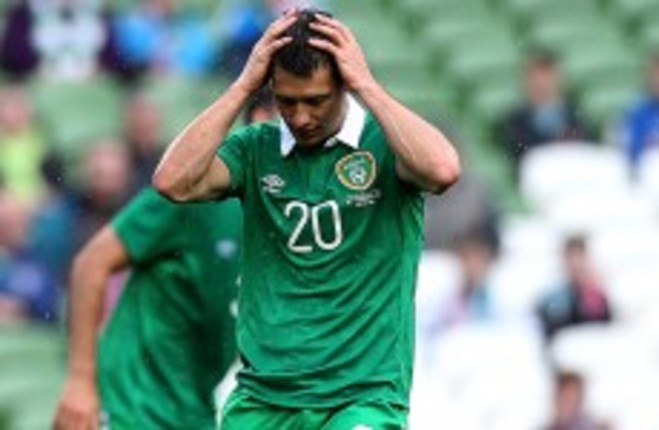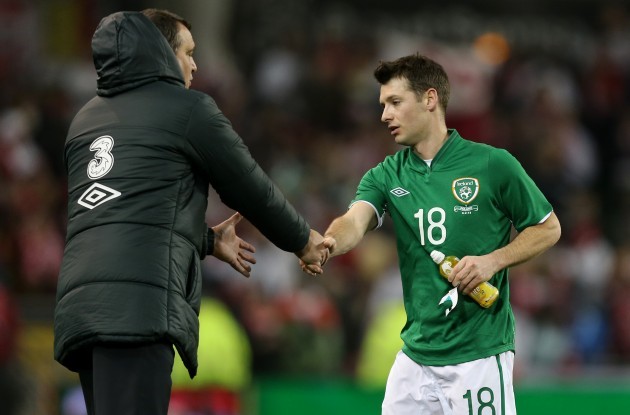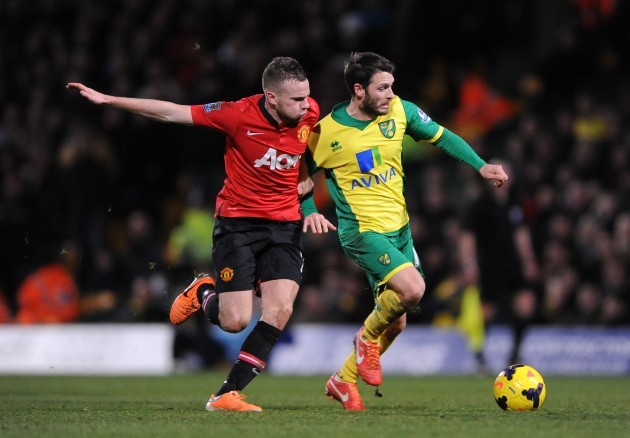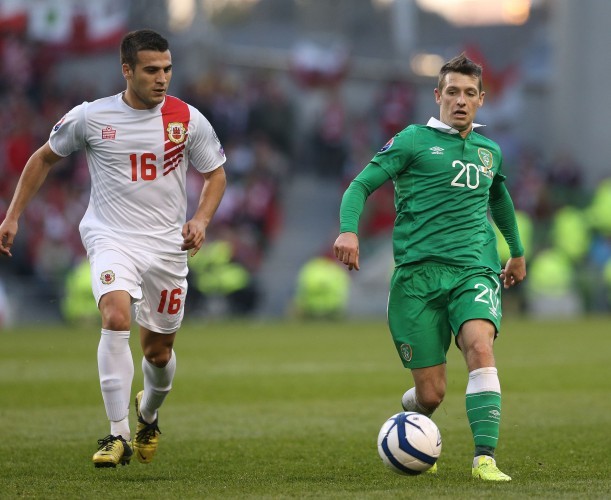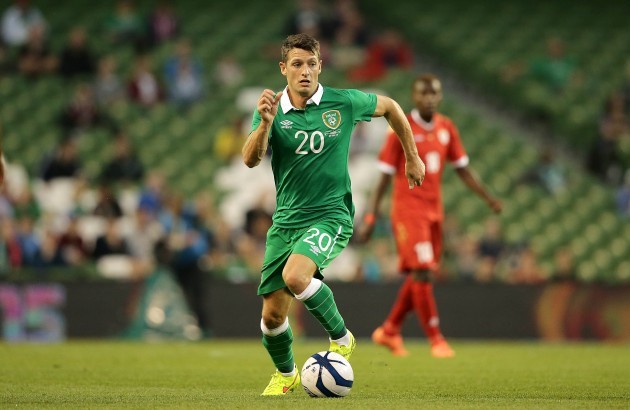THERE’S SOMETHING ABOUT the enigmatic genius, the under-appreciated artist, loved by some and shunned by others.
The moments of quality, seen or heard by so few, become mythologised. Their strengths exaggerated, their weaknesses ignored.
But their truth falls somewhere in the middle. And perhaps that’s their biggest problem.
Wes Hoolahan made his debut for Ireland in the summer of 2008 and is still to hit twenty caps. Only last year, in a 4-0 home win against Georgia, did the 32 year-old make his first competitive start. Yet, many obsess over why the midfielder isn’t an automatic first-choice player under Martin O’Neill. They argue that he gives the team a poise, a grace, an elegance. They say he can open defences, play clever passes and create opportunities for others. Why, they cry, is he being repeatedly overlooked?
Under Giovanni Trapattoni, the Irish side lacked any polish. Often, it seemed chaotic. The Italian made his mind up early that the players were limited and the tactics were basic. It was a throwback. Ireland were hard to beat but rarely won themselves. Rightly or wrongly, it was a pragmatic approach and though aesthetically unpleasant, the strategy worked. Trapattoni got the team to the brink of a World Cup and qualified for the European Championship. Then, the side was humiliated and everything positive that had been achieved was quickly forgotten.
The fact that a foreign coach, with a simplistic grasp of a version of the English language, had worked minor miracles in getting a group of young players – the bulk playing with mid-to-low level Premier League teams or worse, to a major international tournament was glossed over. Instead, many argued that the reason the team performed so badly was because the system was broken. Trapattoni, they said, talked relentlessly about the players’ limitations. We had gifted personnel, they said, like Wes Hoolahan. All they needed was a chance.
If Hoolahan was ever going to get a real opportunity under Trapattoni, it should’ve come in 2010 when the midfielder was in the form of his life at Norwich. He scored ten league goals as the club won automatic promotion to the Premier League. But, Trapattoni was already two years into his stint as manager, had just got his Irish team to within a whisker of a major competition and had already refused to accommodate a similar style of player, Andy Reid, into his starting XI. Infamously, Reid was banished from the setup after clashing with Trapattoni following a World Cup qualifier win against Georgia in September 2008.
There was also the system to contend with. Trapattoni played a rigid 4-4-2. In the middle of midfield, he liked an honest, hard-working pair (two from Whelan, Reid, Andrews) and with a couple of wingers and two strikers, felt happy with his offensive options. Hoolahan didn’t fit. There was a general acceptance that Ireland didn’t require further assistance in the final third but in a deeper midfield zone instead and the rapid development of James McCarthy was the biggest and most radical element of Trapattoni’s reign. The trust was in the system rather than the players and there was little room for Hoolahan.
By the time Trapattoni finally moved on in September 2013, Hoolahan was finding it difficult at club level too. Norwich had spent big on new signings. The silky midfielder was usurped for others. It all felt eerily familiar. There was little room for him anymore.
In early December at Anfield, he was hauled off after an hour as Liverpool thumped five past the Canaries. He had enough and agitated for a move elsewhere. But only one club showed a firm interest. His former boss Paul Lambert wanted to bring him to Aston Villa. But as much as Lambert coveted Hoolahan, the Midlands’ club put forward a bid of a measly £1m. Unwanted and unloved, the Dubliner spent the rest of the campaign drifting in and out of the side but the club’s relegation granted him a reprieve.
The bigger names left, the wage bill needed shredding but Hoolahan was prepared to stay and prove people wrong. He signed a new two-year deal in the summer. This season, he’s played on the left side of midfield with Neil Adams preferring a 4-4-2 and two hard-working, resolute central midfielders and a pair of strikers. It all feels eerily familiar.
The arrival of Martin O’Neill seemed certain to re-open the international door for him, to rekindle his love affair with playing for his country. But, for his first competitive game in charge against Georgia last month, O’Neill played three central midfielders and Hoolahan wasn’t one of them.
Rather damningly, O’Neill has spoken repeatedly of Hoolahan’s importance for home internationals, hinting that a regular role for him is a luxury he’s not willing to entertain. There was a cursory appearance against the hapless Gibraltar, the perfect opposition for Hoolahan to excel against. With lots of space to exploit, with little pressure on him and with his team-mates allowed the freedom of the Aviva Stadium, he could create at will. But amongst the goals and the assists and the fanfare and the applause, there was something lamentable about the whole sorry episode.
That Hoolahan was reduced to something akin to a testimonial seemed embarrassing. But maybe it was just real. Maybe, after all the myths, it was a neat full-stop and the start of a new sentence. Maybe this is the start of accepting Hoolahan as a squad player and nothing more. That he has limitations, that Trapattoni and Chris Hughton and O’Neill haven’t all been blinded by some pre-determined hatred for Wes Hoolahan. That maybe he’s not as good as so many people think he is.
Speaking recently about Hoolahan, Brian Kerr said the following:
“It’s accommodating him in a system that doesn’t leave you too open in the middle of the pitch. That Martin O’Neill went for Stephen Quinn ahead of Wes in Georgia was an indication that the manager has doubts about Wes. That in a tough away game, he felt he needed to be tight. The managers who play him, love him. The managers who don’t play him have a reason why they don’t. Not every manager has played him consistently, even Chris Hughton – a great manager and a very good judge of player. But yet he didn’t always play Wesley and ended up in a bit of a dispute with him.”
There are flaws in Wesley’s make-up as a player. I have no doubts about his work-rate and his energy. His lack of physicality is something that happens to be there. You might say Iniesta and Xavi weren’t too big or strong but they had a core strength that seemed to be an ability to slay the biggest Goliaths around them. They were able to hold onto it. Wesley does get brushed off it a bit at times during matches. I love him and I’d love to be able to play him in the team but I understand managers who say ‘I’ve got to compromise a bit’ or ‘I need us to be a little more solid’.”
Against Germany, Hoolahan came on as a substitute for the last fourteen minutes. He could’ve scored only for Erik Durm to block superbly in the penalty area. In injury time, as Ireland desperately chased the game, Hoolahan looked to send in a cross from the right side. He over-hit it. Jeff Hendrick did magnificently to hook the ball back inside and John O’Shea flicked it expertly to the far corner.
On RTE, Ronnie Whelan spoke of the ‘little bit of magic from Hoolahan’. Moments later, Eamon Dunphy spoke of how the media and Martin O’Neill had ‘messed Hoolahan around’ and that his confidence had been affected. “But he found it”, said Dunphy. ‘He found the right ball at the end.”
Perpetuating a myth doesn’t do anyone any use. Least of all the person at the centre of it.
